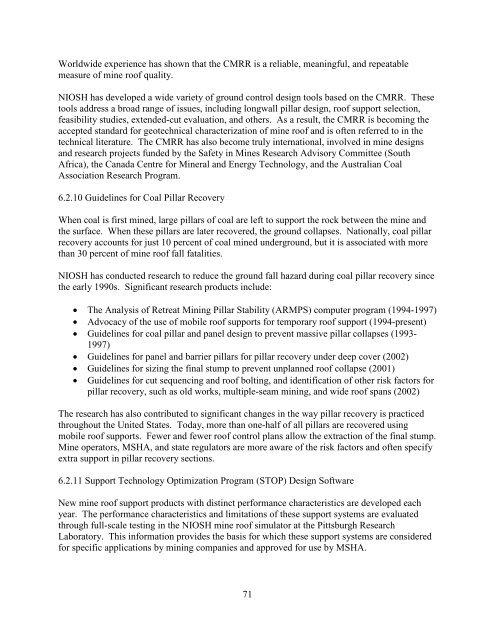One Hundred Years of Federal Mining Safety and Health Research
One Hundred Years of Federal Mining Safety and Health Research
One Hundred Years of Federal Mining Safety and Health Research
- No tags were found...
Create successful ePaper yourself
Turn your PDF publications into a flip-book with our unique Google optimized e-Paper software.
Worldwide experience has shown that the CMRR is a reliable, meaningful, <strong>and</strong> repeatable<br />
measure <strong>of</strong> mine ro<strong>of</strong> quality.<br />
NIOSH has developed a wide variety <strong>of</strong> ground control design tools based on the CMRR. These<br />
tools address a broad range <strong>of</strong> issues, including longwall pillar design, ro<strong>of</strong> support selection,<br />
feasibility studies, extended-cut evaluation, <strong>and</strong> others. As a result, the CMRR is becoming the<br />
accepted st<strong>and</strong>ard for geotechnical characterization <strong>of</strong> mine ro<strong>of</strong> <strong>and</strong> is <strong>of</strong>ten referred to in the<br />
technical literature. The CMRR has also become truly international, involved in mine designs<br />
<strong>and</strong> research projects funded by the <strong>Safety</strong> in Mines <strong>Research</strong> Advisory Committee (South<br />
Africa), the Canada Centre for Mineral <strong>and</strong> Energy Technology, <strong>and</strong> the Australian Coal<br />
Association <strong>Research</strong> Program.<br />
6.2.10 Guidelines for Coal Pillar Recovery<br />
When coal is first mined, large pillars <strong>of</strong> coal are left to support the rock between the mine <strong>and</strong><br />
the surface. When these pillars are later recovered, the ground collapses. Nationally, coal pillar<br />
recovery accounts for just 10 percent <strong>of</strong> coal mined underground, but it is associated with more<br />
than 30 percent <strong>of</strong> mine ro<strong>of</strong> fall fatalities.<br />
NIOSH has conducted research to reduce the ground fall hazard during coal pillar recovery since<br />
the early 1990s. Significant research products include:<br />
• The Analysis <strong>of</strong> Retreat <strong>Mining</strong> Pillar Stability (ARMPS) computer program (1994-1997)<br />
• Advocacy <strong>of</strong> the use <strong>of</strong> mobile ro<strong>of</strong> supports for temporary ro<strong>of</strong> support (1994-present)<br />
• Guidelines for coal pillar <strong>and</strong> panel design to prevent massive pillar collapses (1993-<br />
1997)<br />
• Guidelines for panel <strong>and</strong> barrier pillars for pillar recovery under deep cover (2002)<br />
• Guidelines for sizing the final stump to prevent unplanned ro<strong>of</strong> collapse (2001)<br />
• Guidelines for cut sequencing <strong>and</strong> ro<strong>of</strong> bolting, <strong>and</strong> identification <strong>of</strong> other risk factors for<br />
pillar recovery, such as old works, multiple-seam mining, <strong>and</strong> wide ro<strong>of</strong> spans (2002)<br />
The research has also contributed to significant changes in the way pillar recovery is practiced<br />
throughout the United States. Today, more than one-half <strong>of</strong> all pillars are recovered using<br />
mobile ro<strong>of</strong> supports. Fewer <strong>and</strong> fewer ro<strong>of</strong> control plans allow the extraction <strong>of</strong> the final stump.<br />
Mine operators, MSHA, <strong>and</strong> state regulators are more aware <strong>of</strong> the risk factors <strong>and</strong> <strong>of</strong>ten specify<br />
extra support in pillar recovery sections.<br />
6.2.11 Support Technology Optimization Program (STOP) Design S<strong>of</strong>tware<br />
New mine ro<strong>of</strong> support products with distinct performance characteristics are developed each<br />
year. The performance characteristics <strong>and</strong> limitations <strong>of</strong> these support systems are evaluated<br />
through full-scale testing in the NIOSH mine ro<strong>of</strong> simulator at the Pittsburgh <strong>Research</strong><br />
Laboratory. This information provides the basis for which these support systems are considered<br />
for specific applications by mining companies <strong>and</strong> approved for use by MSHA.<br />
71
















